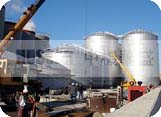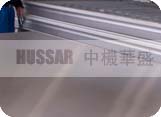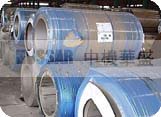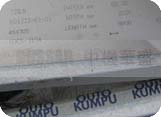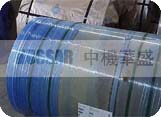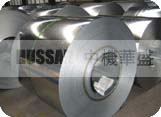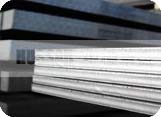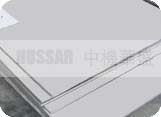| 2507(UNS S32750)
Duplex Stainless Steel 1.4410
------------------------------------------------------------------ General
Properties
Duplex Stainless Steel 2507 is a super duplex stainless steel with 25% chromium,
4% molybdenum, and 7% nickel designed for demanding applications which require
exceptional strength and corrosion resistance, such as chemical process, petrochemical,
and seawater equipment. The steel has excellent resistance to chloride stress
corrosion cracking, high thermal conductivity and a low coefficient of thermal
expansion. The high chromium, molybdenum, and nitrogen levels provide excellent
resistance to pitting, crevice, and general corrosion.
The
impact strength is also high. Alloy 2507 is not recommended for applications
which require long exposures to temperatures above 570F because of the risk of
a reduction in toughness. ------------------------------------------------------------------ Applications Oil
and gas industry equipment
Offshore platforms, heat exchangers, process and
service water systems, fire-fighting systems, injection and ballast water systems
Chemical process industries, heat exchangers, vessels, and piping
Desalination
plants, high pressure RO-plant and seawater piping
Mechanical and structural
components, high strength, corrosion-resistant parts
Power industry FGD systems,
utility and industrial scrubber systems, absorber towers, ducting, and piping
------------------------------------------------------------------ Standards
ASTM/ASME .......... A240 - UNS S32750
EURONORM............ 1.4410 - X2 Cr
Ni MoN 25.7.4
AFNOR.................... Z3 CN 25.06 Az ------------------------------------------------------------------ Corrosion
Resistance
General Corrosion
The high chromium and molybdenum content
of 2507 makes it extremely resistant to uniform corrosion by organic acids
like formic and acetic acid. 2507 also provides excellent resistance to inorganic
acids, especially those containing chlorides. In
dilute sulfuric acid contaminated with chloride ions, 2507 has better corrosion
resistance than 904L, which is a highly alloyed austenitic steel grade specially
designed to resist pure sulfuric acid. Stainless
steel of type 316L (2.5%Mo) cannot be used in hydrochloric acid due to the risk
of localized and uniform corrosion. However, 2507 can be used in dilute hydrochloric
acid. Pitting need not be a risk in the zone below the borderline in this figure,
but crevices must be avoided. Intergranural
Corrosion
2507’s low carbon content greatly lowers the risk of carbide
precipitation at the grain boundaries during heat treatment; therefore, the alloy
is highly resistant to carbide-related intergranular corrosion. Stress
Corrosion Cracking
The duplex structure
of 2507 provides excellent resistance to chloride stress corrosion cracking
(SCC). Because of its higher alloy content, 2507 is superior to 2205 in corrosion
resistance and strength. 2507 is especially useful in offshore oil and gas
applications and in wells with either naturally high brine levels or where brine
has been injected to enhance recovery. Pitting
Corrosion
Different testing methods can be used to establish the pitting
resistance of steels in chloride-containing solutions. The data above were measured
by an electrochemical technique based on ASTM G 61. The critical pitting temperatures
(CPT) of several high-performance steels in a 1M sodium chloride solution were
determined. The results illustrate the excellent resistance of 2507 to pitting
corrosion. The normal data spread for each grade is indicated by the dark gray
portion of the bar. Crevice Corrosion
The presence of crevices, almost unavoidable in practical constructions and operations,
makes stainless steels more susceptable to corrosion in chloride enviroments.
2507 is highly resistant to crevice corrosion. The critical crevice corrosion
temperatures of 2507 and several other high-performance stainless steels are
shown above. ------------------------------------------------------------------ Chemical
Analysis
Typical values (Weight %) C
Cr Ni Mo N Others
0.020 25 7 4.0 .27 S=0.001
PREN = [Cr%]
+ 3.3 [Mo%] + 16 [N%] ≥ 40 ------------------------------------------------------------------ Mechanical
Properties
2507 combines high tensile and impact strength with
a low coefficient of thermal expansion and high thermal conductivity. These properties
are suitable for many structural and mechanical components. The low, ambient,
and elevated temperature mechanical properties of 2507 sheet and plate are
shown below. All of the test data shown are for samples in the annealed and quenched
condition. 2507 is not recommended
for applications which require long exposures to temperatures in excess of 570F
because of the increased risk of a reduction in toughness. The data listed here
are typical for wrought products and should not be regarded as a maximum or minimum
value unless specifically stated. Mechanical
Properties
Ultimate Tensile Strength,
ksi 116 min.
0.2% Offset Yield Strength 0.2%, ksi 80 min.
0.1% Offset
Yield Strength 0.2%, ksi 91 min.
Elongation in 2 inches, % 15 min.
Hardness
Rockwell C 32 max.
------------------------------------------------
Hot forming
2507 should be hot worked between 1875F and 2250F.
This should be followed by a solution anneal at 1925F minimum and a rapid air
or water quench. Cold Forming
Most of the common stainless steel forming methods can be used for cold working
2507. The alloy has a higher yield strength and lower ductility than the austenitic
steels so fabricators may find that higher forming forces, increased radius of
bending, and increased allowance for springback are necessary. Deep drawing, stretch
forming, and similar processes are more difficult to perform on 2507 than
on an austenitic stainless steel. When forming requires more than 10% cold deformation,
a solution anneal and quench are recommended. Heat
Treatment
2507 should be solution annealed and quenched after either
hot or cold forming. Solution annealing should be done at a minimum of 1925F.
Annealing should be followed immediately by a rapid air or water quench. To obtain
maximum corrosion resistance, heat treated products should be pickled and rinsed.
----------------------------------------------- Welding
2507 possesses good weldability and can be joined to itself or other materials
by shielded metal arc welding (SMAW), gas tungsten arc welding (GTAW), plasma
arc welding (PAW), flux cored wire (FCW), or submerged arc welding (SAW). 2507/P100
filler metal is suggested when welding 2507 because it will produce the appropriate
duplex weld structure. Preheating
of 2507 is not necessary except to prevent condensation on cold metal. The
interpass weld temperature should not exceed 300F or the weld integrity can be
adversely affected. The root should be shielded with argon or 90% N2/10% H2 purging
gas for maximum corrosion resistance. The latter provides better corrosion resistance. If
welding is to be done on only one surface and post-weld cleaning is not possible,
GTAW is suggested for root passes. GTAW or PAW should not be done without a filler
metal unless post-weld cleanup is possible. A heat input of 5-38 kJ/in. should
be used for SMAW or GTAW. A heat input of about 50kJ/in. can be used for SAW. | 
